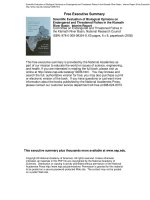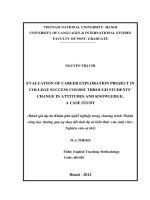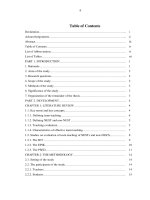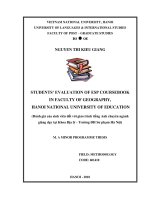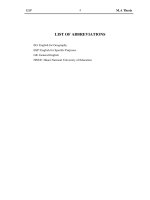Evaluation of Haemato-biochemical parameters using different biomaterials in fracture healing of dogs
Bạn đang xem bản rút gọn của tài liệu. Xem và tải ngay bản đầy đủ của tài liệu tại đây (206.24 KB, 7 trang )
Int.J.Curr.Microbiol.App.Sci (2019) 8(5): 2265-2271
International Journal of Current Microbiology and Applied Sciences
ISSN: 2319-7706 Volume 8 Number 05 (2019)
Journal homepage:
Original Research Article
/>
Evaluation of Haemato-Biochemical Parameters using Different
Biomaterials in Fracture Healing of Dogs
Astha Chaurasia1*, Shobha Jawre1, Randhir Singh1, Apra Shahi1,
Rekha Pathak2, Babita Das1 and Naveen Kumar Verma2
1
Department of Veterinary Surgery & Radiology, NDVSU, Jabalpur, 482001, (MP), India
2
Division of Surgery, ICAR-IVRI, Izatnagar, Bareilly, 243122, (UP), India
*Corresponding author
ABSTRACT
Keywords
Fracture, Titanium
pin, Decellularised
bone chip graft, βTCP, Haematobiochemical
examination
Article Info
Accepted:
18 April 2019
Available Online:
10 May 2019
The present study was conducted on 12 dogs of either, sex, breed, aged between 1-8 years
brought to T.V.C.C, Jabalpur having a diaphyseal fracture in any of the long bones i.e.
Humerus, femur and tibia. The dogs were randomly divided into three equal groups
irrespective of breed and sex. The radiographs in two standard views were taken to
diagnose the fracture and to select optimum titanium pins. In all the three groups, the
diaphyseal fractures were repaired with internal fixation using titanium elastic pin. In
group I, the fracture was repaired by using the titanium pin alone. In group II, along with
internal fixation bone loss or bone gap in fractures site were filled by decellularised
xenogeneic cancellous bone chip graft, while in group III, bone loss or gap at fracture site
was filled and packed with granules of beta tricalcium phosphate (β- TCP). A 5 ml blood
was collected from each animal on the day of surgery and at different time intervals up to
60th post-operative day for haemato-biochemical estimation. Haemato-biochemical
parameters like haemoglobin, total erythrocyte count, total leucocyte counts and
differential leukocyte count included neutrophil, lymphocyte, eosinophil, basophil and
monocyte activity and serum calcium, phosphorus and alkaline phosphatase enzyme
activity during fracture healing were analyzed and found that the above all haematobiochemical parameters on different post-operative days provided much help in assessing
source of fracture healing.
Introduction
Bone healing is a complex physiological
process and involves numerous mechanisms
at tissue and cellular levels. This phenomenon
differs from that of soft tissue because of its
morphology and composition. Healing of
bone is a slow process and therefore requires
extra physical and mechanical support which
could be external and internal fixations or
implants. Amongst the materials available for
implant applications the selection of titaniumbased materials for implant, is due to the
combination of its outstanding characteristics
such as high strength, low density (high
specific strength), high immunity to
corrosion, complete inertness to body
environment, enhanced biocompatibility, low
2265
Int.J.Curr.Microbiol.App.Sci (2019) 8(5): 2265-2271
modulus and high capacity to join with bone
and other tissues (Niinomi, 2001).
A number of biomaterials have shown the
ability to induce bone formation when
implanted at fracture sites, an ability known
as osteoinduction. Such osteoinductive
biomaterials hold great potential for the
development of new therapies in bone
regeneration (Barradas et al., 2011).
Tricalcium phosphate believed to be
osteoconductive and their small sized
particles have interconnected; microporacity
offers excellent
bio-reabsorbable and
biocompatible properties and promote process
of remodeling (Erbe et al., 2001).
Decellularised bone graft contains natural
extra cellular matrix which provides structural
support, growth factors and cytokines that are
naturally stored within bone matrix to guide
bone tissue formation (Gomes et al., 2006).
Haemato-biochemical
parameters
like
haemoglobin, total erythrocyte count, total
leukocyte counts and differential leucocyte
count included neutrophil, lymphocyte,
eosinophil, basophil and monocyte activity
and serum calcium, phosphorus and alkaline
phosphatase enzyme activity during fracture
healing were analyzed and evaluated.
Assessment of fracture healing based on
fluctuation
of
haemato-biochemical
parameters during fracture healing is still
debatable. More ever, there is a paucity of
data describing the role of these parameters in
healing of fractures. Hence, present study was
conducted to evaluate haemato-biochemical
parameters during fracture healing in 12 dogs.
Materials and Methods
Twelve dogs of different breeds of either sex
presented to Department of Surgery and
Radiology, College of Veterinary Science and
A.H., NDVSU, Jabalpur, with the long bone
fractures, were selected for the study. Clinical
symptoms before surgery were, swelling on
affected area, evince crepitating sound and
pain on palpation and limping were also
recorded.
The radiographs in two standard views were
taken to diagnose the fracture and to select
optimum titanium pins. Out of twelve
animals, six animals had overriding, four
animals had multiple and remaining two had
oblique fracture of different long bones.
All the twelve animals were randomly divided
into three groups. Group I was taken as
control in which the internal fixation was
done by using titanium pin alone, in group II
along with the internal fixation by titanium
pin decellularised xenogeneic cancellous bone
chip graft (DXBG) was filled at the fracture
site and in animals of group III along with the
internal fixation with titanium pin the sterile
synthetic β-tricalcium phosphate (β-TCP) was
placed at fracture site. In all the groups,
pinning was performed as per the standard
procedure described by Singh et al., (2015).
A 5 ml blood was collected from each animal
on the day of surgery and further at different
time intervals up to 60th post-operative day for
haemato-biochemical parameters estimation.
The days of blood collection were 0, 15, 30,
45 and 60th day for biochemical parameters
analysis and on 0, 7, 15 and 30th day for
haematological parameters respectively. The
blood was collected in EDTA vial for
haematology and serum clot activator vial for
harvesting serum from the blood samples. The
collected serum was subjected to estimation
of serum calcium, serum phosphorus and
alkaline phosphatase.
The data obtained during the experiment were
subjected to statistics by one-way analysis of
variance (ANOVA) described by Snedecor
and Cochran (1994).
2266
Int.J.Curr.Microbiol.App.Sci (2019) 8(5): 2265-2271
Results and Discussion
Haematological parameters
Haemoglobin
The mean values of haemoglobin showed
significant(p<0.05) decrease at 7 day intervals
in the animals of all the three groups.
However, from 15-30 days values returned to
its normal level. The significant decreased
might be attributed to presence of more
inflammation till 7th day in group I animals
than remaining two groups and due to the
physical stress at the time of fracture, loss of
blood during surgery, as well as
haemodilution and anesthesia during internal
fixation procedure. The above findings are in
accordance with the findings of Tembhurne et
al., (2010) (Table 1).
Total erythrocyte count
Total erythrocyte count showed nonsignificant decreased on 7th day, followed by
increase on 15th and 30th day in group I and III
respectively. Whereas, dogs of group II
showed non-significant increased on 15 day
followed by significant increased (p<0.05) on
30th day. The transient fall in total erythrocyte
count may be attributed to mild hemorrhages
during surgical procedure or sequestration of
RBC to spleen as opinioned by Lobo et al.,
(2013). The observations are also correlated
with the findings of Aithal et al., (1998)
(Table 1).
Total leucocyte count
The mean leucocyte count expressed a nonsignificant decreasing pattern at most of the
operative intervals in all the animals of three
groups which was within the reference range
as quoted by Aiello and Mays, (1998). This
gradual decrease at different post-operative
days was indicative of return to normal
condition after fracture in dogs. Further, nonsignificantly higher values in all the groups at
0 day may be attributed to the systemic
inflammatory changes after fracture as
supported by the findings of Toth et al.,
(2014) who observed an elevated leucocyte
count in early post-operative period in beagle
dogs (Table 1).
Differential leukocyte count
Neutrophil
The mean neutrophil count showed a gradual
non-significant decreasing trend in animals of
group II and III from 7 to 30 day, while
significant increase (p<0.05) was observed in
animals of group I from 7 to 15 day followed
by significant decrease and value return to its
normal range. The significant increase in
neutrophil count (%) in animals of group I
may be attributed to extent of trauma leading
to inflammation and invasion of other
infection according to the findings of
Saravanan (2002) and Khan et al., (2011)
Whereas, the neutrophil count was
significantly less in group II as compare to
group III and I respectively. This might be
attributed due to the histocompatible
biomaterials used at fracture site reduces
inflammatory responses and leads to
progressive fracture healing without any
exudation (Table 1).
Lymphocyte
A significant increased (p<0.05) in
lymphocyte count was observed on 7 and 15
day interval in group I, II and III respectively.
Thereafter, the values returned to its normal
range on 30 day in all the groups.
This can be attributed to relative variation in
neutrophil count which increases initially
after surgical intervention and further
2267
Int.J.Curr.Microbiol.App.Sci (2019) 8(5): 2265-2271
activates the production of immune regulatory
cytokines by macrophages and monocyte.
Cytokines are responsible for activation of
adrenal axes and increase production of
glucocorticoids, which might be responsible
for lyses of lymphoid tissue and circulating
lymphocytes (Kaneko, 1997). Khan et al.,
(2011) also observed a wider observation
range of lymphocyte count in stray dogs in
Asian continent.
The neutrophil are the first line of cellular
defense of the body and leucocytosis (due to
neutrophilia and monocytosis – second line of
cellular defense), is generally observed during
the initial stages of inflammation (Schalm et
al., 1975 and Sastry, 1989) (Table 1).
Eosinophil count
The mean eosinophil count showed nonsignificant difference at different intervals in
all animals of three groups.
All the values were within reference range as
quoted by Aiello and Mays (1998). Similarly,
Zama et al., (1999), also reported nonsignificant variation in eosinophil count
during post-operative acupuncture therapy in
femoral fracture repair in dogs (Table 1).
Basophil
The mean basophil count showed a nonsignificant difference among groups or within
group at different time interval (Table 1).
Monocyte
The mean monocyte count showed nonsignificant variations at different time interval
in the animals of all the groups according to
the Aiello and Mays (1998) and Zama et al.,
(1999), also reported non-significant variation
in monocyte count during fracture healing in
dogs (Table 1).
Serum biochemical parameters
Serum calcium
The serum calcium level on 15 post-operative
days was significantly (p<0.05) less when
compared to other post-operative day in all
the animals of three groups. The gradual
decrease in serum calcium level might be due
to deposition of the excessive calcium at the
fracture site and further increase in its value
on 45 to 60 day attributed to remodeling
phase. However, calcium level fluctuation
was higher in the animals of group II and III
with biomaterial as compare to animals of
group I without biomaterial. The above
findings are in accordance with the finding of
Komnenou et al., (2005) and Rajhans (2013)
(Table 2).
Serum phosphorus
The serum phosphorus showed nonsignificantly decreased on 15th day interval.
However, the value of serum phosphorous
fluctuated within the normal physiological
limits. This might be attributed to osteoclastic
activity leading to resorption of dead bone
resulting in gradual decrease in serum
phosphorous as observed in present study.
These results are in agreement with the
findings of Pandey and Udapa (1981) and
Rajhans (2013) (Table 2).
Alkaline phosphatase
The serum alkaline phosphatase level was
significantly(p<0.05) increase on 15 postoperative day thereafter it decreases from 45
to 60 day post operatively in all the animals of
three group. This may be attributed due to
implantation of osteoinductive biomaterials at
fracture site, further increases the osteoblastic
activity.
2268
Int.J.Curr.Microbiol.App.Sci (2019) 8(5): 2265-2271
Table.1 Mean ± SE values of haematological parameters of different groups at different time
intervals
S.no.
1.
Parameter
Haemoglobin
(g/dl)
2.
Total erythrocyte
count(106/µl)
3.
Total Leucocyte
count(103/µl)
4.
Neutrophil(%)
5.
Lymphocyte(%)
6.
Eosinophil
count(%)
7.
Basophil(%)
8.
Monocyte(%)
Groups
I
II
III
I
II
III
I
II
III
I
II
III
I
II
III
I
II
III
I
II
III
I
II
III
0th day
13.05a±0.37
13.25±0.45
13.63a ±0.24
6.31±0.64
6.19b±0.51
6.10 ± 0.25
14.55±0.02
13.23±1.60
14.48±0.06
72.30±1.32
76.00±4.14
78.75±1.49
21.25b±3.38
16.50b±3.43
14.75c±1.89
1.50±0.87
1.25±0.75
0.25±0.25
0.16±0.16
0.00±0.00
0.00±0.00
3.25±0.48
1.25±0.63
0.25±0.25
7th day
9.55b±0.56
10.65b±0.52
10.28b±0.60
5.99±0.55
5.84±0.16
5.71 ± 0.74
14.38±0.05
11.60±0.92
14.40±0.10
81.00Aa±0.91
75.25B±1.84
77.50B±0.22
37.75Aa±3.01
25.25Ba±2.43
34.25Aa±1.65
2.00±0.71
0.50±0.50
0.75±0.48
0.00±0.00
0.00±0.00
0.00±0.00
2.50±0.29
0.75±0.48
0.50±0.29
15th day
11.53ab±0.84
11.53ab±0.31
11.90ab±0.47
6.11±0.51
7.17±0.44
6.08 ±0.18
14.31±0.07
11.03±2.41
14.23±0.08
80.00Aa±6.06
74.25B±4.17
76.33B±6.21
33.75a±0.85
23.25ab±0.63
33.75a±0.85
0.25±0.25
0.75±0.48
1.75±0.85
0.00±0.00
0.00±0.00
0.00±0.00
3.00±0.91
0.75±0.48
1.00±0.71
30th day
12.05a±0.82
11.95ab±0.88
11.13b±0.85
6.52±0.26
7.65a±0.76
6.30 ± 0.42
14.26±0.09
10.45±1.34
13.73±2.10
73.50Ab±3.18
67.50B±3.48
75.83AB±0.30
23.75Ab±1.89
17.25Bb±1.11
24.50Ab±1.04
3.50±1.85
1.75±0.85
2.50±1.26
0.16±0.16
0.00±0.00
0.00±0.00
2.50±0.96
2.00±0.71
1.25±0.48
Mean value within interval (lowercase) with different superscript differed significantly (p<0.05)
Table.2 Mean ± SE values of serum biochemical parameters of different groups at different time
intervals
S.no.
1.
2.
3.
Parameter Groups
0th day
15th day
9.56ab±0.23 7.59ab±0.47
Serum
I
calcium
11.26b±0.62 7.00c±0.46
II
(mg/dl)
10.07a±0.49 7.10b±0.43
III
3.89±0.70
3.17±0.46
Serum
I
a
phosphorous
4.22 ±0.46
2.27c±0.42
II
(mg/dl)
5.91±3.43
3.73±1.18
III
108.08±7.0 112.9±12.0
Alkaline
I
phosphatase
128.7b±12.3 172.8ab±20.2
II
(IU/L)
122.8b±9.6 168.73ab±4.9
III
30th day
45th day
60th day
9.66ab±0.77 10.50ab±0.24 9.85a±0.62
7.83c±0.35 10.39b±0.42 10.90a ±0.29
9.59a±0.99 10.05a±0.47 10.79a±0.42
4.38±0.48
3.83±0.44
4.54±0.41
bc
ab
2.89 ±0.20 3.59 ±0.21
4.59a±0.52
4.79±1.49
5.21±1.35
5.30±0.79
131.5±11.4 116.5±12.2
111.6±12.2
a
b
197.2 ±22.1 147.13 ±2.9 145.75b±9.9
191.2a±41.9 148.8ab±12.2 140.8ab±11.1
Mean value within interval (lowercase) with different superscript differed significantly (p<0.05)
2269
Int.J.Curr.Microbiol.App.Sci (2019) 8(5): 2265-2271
As osteoblast secretes large quantities of
alkaline phosphatase, which is involved in the
process of matrix formation and its
mineralization. Alkaline phosphatase is
believed to either increase the concentration
of local inorganic phosphate or inorganic
pyrophosphate that is necessary for fracture
healing (Volpin et al., 1998) (Table 2).
On the basis of above findings it can be
concluded that, changes in the haematobiochemical parameters at different postoperative days is directly correlated with the
different phases of fracture healing.
References
Aiello, S.E. and Mays, A. (1998). The Merck
Veterinary Manual, 8th Edn., Merck &
Co., Inc, Whitehouse station, New
Jersey, pp 2188-2195.
Aithal, H.P., Singh, G.R. and Bisht, G.S.
(1998). Incidence of fractures in
different domestic animals – A twenty
year survey analysis. In: 22nd Indian
Society
for
Veterinary
Surgery
Symposium,
Bhubneshwar,
5-7
November, pp. 30-32.
Barradas, M.C., Yuan, H., VanBlitterswijk,
C.A. and Habibovic P. (2011).
Osteoinductive biomaterials: current
knowledge of properties, experimental
models and biological mechanisms.
European Cells and Materials, 21: 407429.
Erbe, E.M., Marx, J.G., Clineff, T.D. and
Bellincampi, L.D. (2001). Potential of
an ultraporous β-tricalcium phosphate
synthetic cancellous bone void filler and
bone marrow aspirate composite graft.
European Spine Journal, 10: 141-146.
Gomes, M.E., Bossano, C.M., Johnston,
C.M., Reis, R.L. and Mikos, A.G.
(2006). In vitro localization of bone
growth factors in constructs of
biodegradable scaffolds seeded with
marrow stromal cells and cultured in a
flow perfusion bioreactor. Tissue
Engineering, 12(1): 177-188.
Komnenou, A., Karayannopoulou, M.,
Polizopoulou, Z.S., Constantinidis, T.C.
and Dessiris, A. (2005). Correlation of
serum alkaline phosphatase activity
with the healing process of long bone
fractures in dogs. Veterinary Clinical
Pathology, 34: 35–38.
Kaneko, J. (1997). Carbohydrate metabolism
and its decrease: blood glucose in
animals. Text Book of Clinical
Biochemistry of Domestic Animals. 5th
Edn., Elsevier publishers, Philadelphia,
U.S.A., pp64.
Khan, S.A., Epstein, J.H., Olival, K.J.,
Hassan, M.M., Hossain, M.B., Rahman,
K.B.M.A., Elahi, M.F., Mamun, M.A.,
Haider, N., Yasin, G. and Desmond, J.
(2011). Hematlogy and serum chemistry
reference values of stray dogs in
Bangladesh. Open Veterinary Journal,
1: 13-20.
Lobo, D., Lewington, A.J.P. and Allison, S.P.
(2013). Basic Concepts of Fluid and
Electrolyte
Therapy.
Bibliomed,
Germany, pp9-22.
Niinomi, M. (2001). Titanium based
biomaterials, the ultimate choice for
orthopaedic implants- A review.
Metallurgical
and
Materials
Transactions, 32: 477–86.
Pandey SK, Udapa KN. Effect of growth
hormone on biochemical response after
fracture in dogs. Indian Journal of
Veterinary Surgery. 1981; 1(2):73-78.
Rajhans, M. (2013). Stabilisation of splinters
of long bone fracture in dogs. M.V.Sc.
& A.H. thesis (Surgery and Radiology),
Nanaji Deshmukh Veterinary Science
University, Jabalpur.
Saravanan, B., Maiti, S.K., Hoque, M., Aithal,
H.P. and Singh, G.R. (2002).
Management of comminuted femoral
fracture by different internal fixation
2270
Int.J.Curr.Microbiol.App.Sci (2019) 8(5): 2265-2271
techniques in dogs. Indian Journal of
Animal Science, 72: 1104-1108.
Sastry, G.A. (1989). Veterinary Clinical
Pathology. 3rd Edn., C.B.S. Publishers
and Distributors Pvt. Ltd., Delhi. pp807.
Schalm, O.W., Jain, N.C. and Carrol, E.J.
(1975). Veterinary Haematology. 3rd
Edn., Lea and Febiger, Pheladelphia.
pp807.
Singh, R., Chandrapuria, V.P., Shahi, A.,
Bhargava, M.K., Swamy, M. and
Shukla,
P.C.
(2015).
Fracture
occurrence pattern in animals. Journal
of Animal Research, 5(3): 611-616.
Snedecor, G.W. and Cochran, W.G. (1994).
Statistical Methods, 8th Edn., Oxford
and IBH Publishing Co., pp291-293.
Tembhurne, R.D., Gahlod, B.M., Dhakate,
M.S., Akhare, M.S., Upadhaye, S.V.
and Bawasker, S. (2010). Management
of femoral fracture with the use of horn
peg in canine. Veterinary World, 3(1):
37-41.
Toth, C., Klaril, Z., Kiss, F., Toth, E.,
Hargitai, Z. and Nemeth, N. (2014).
Early
postoperative
changes
in
haematological, erythrocyte aggregation
and blood coagulation parameters after
unilateral
implantation
of
polytetrafluoroethylene vascular graft in
the femoral artery of Beagle dogs. Acta
Cirurgica Brasileira, 29(5): 320-327.
Volpin, G., Rees, J.A. and Ali, S.A. (1998).
Distribution of alkaline phophatase
activity in experimentally produced
callus in rats. American Journal of Bone
and Joint Surgery, 68: 629-634.
Zama, M.M.S., Gupta, O.P., Singh, G.R. and
Swarup, D. (1999). Postoperative
acupuncture therapy in fracture of
femur. Indian Journal of Veterinary
Surgery, 20(2): 86-87.
How to cite this article:
Astha Chaurasia, Shobha Jawre, Randhir Singh, Apra Shahi, Rekha Pathak,, Babita Das and
Naveen Kumar Verma. 2019. Evaluation of Haemato-Biochemical Parameters using Different
Biomaterials in Fracture Healing of Dogs. Int.J.Curr.Microbiol.App.Sci. 8(05): 2265-2271.
doi: />
2271

